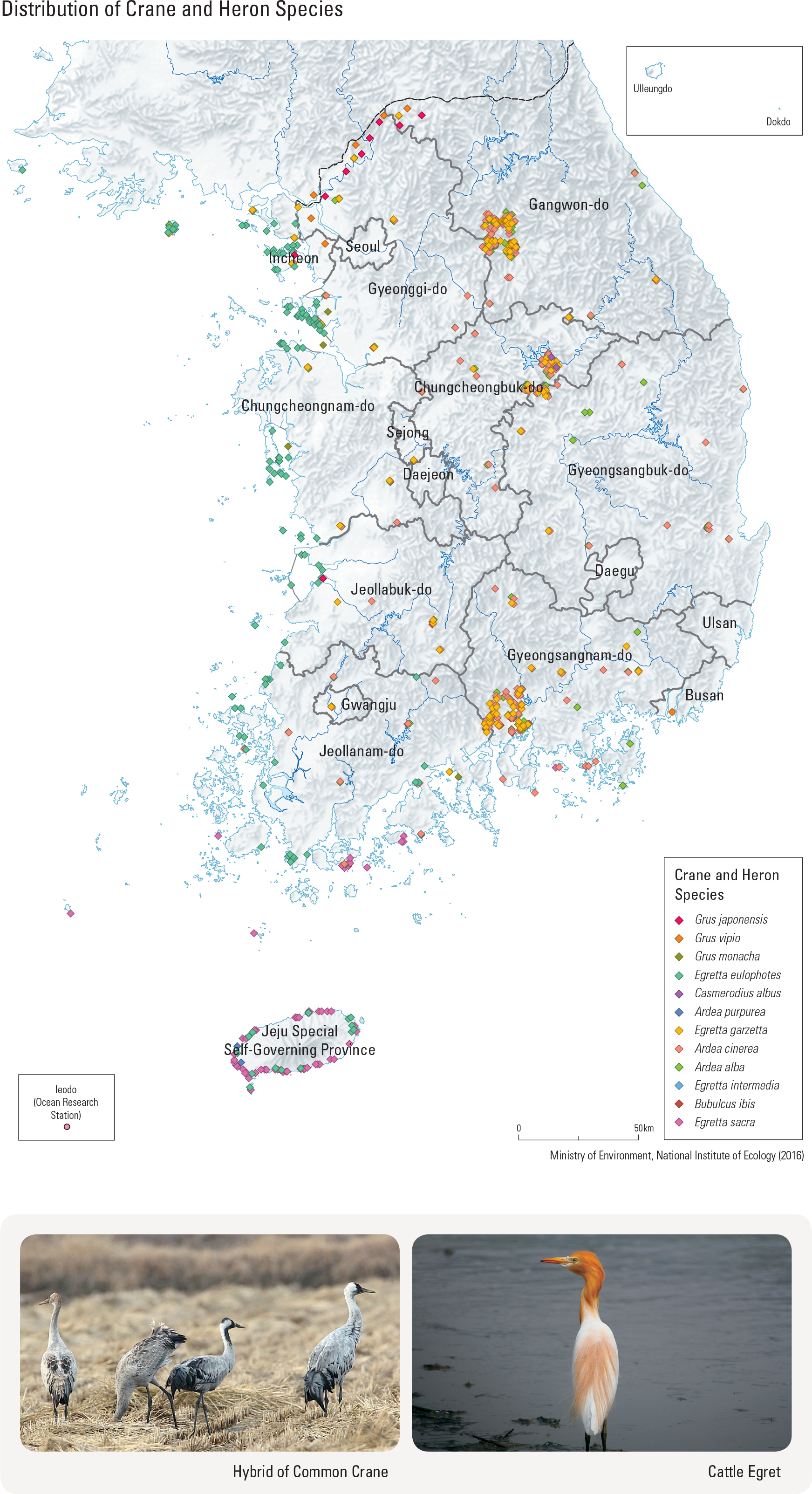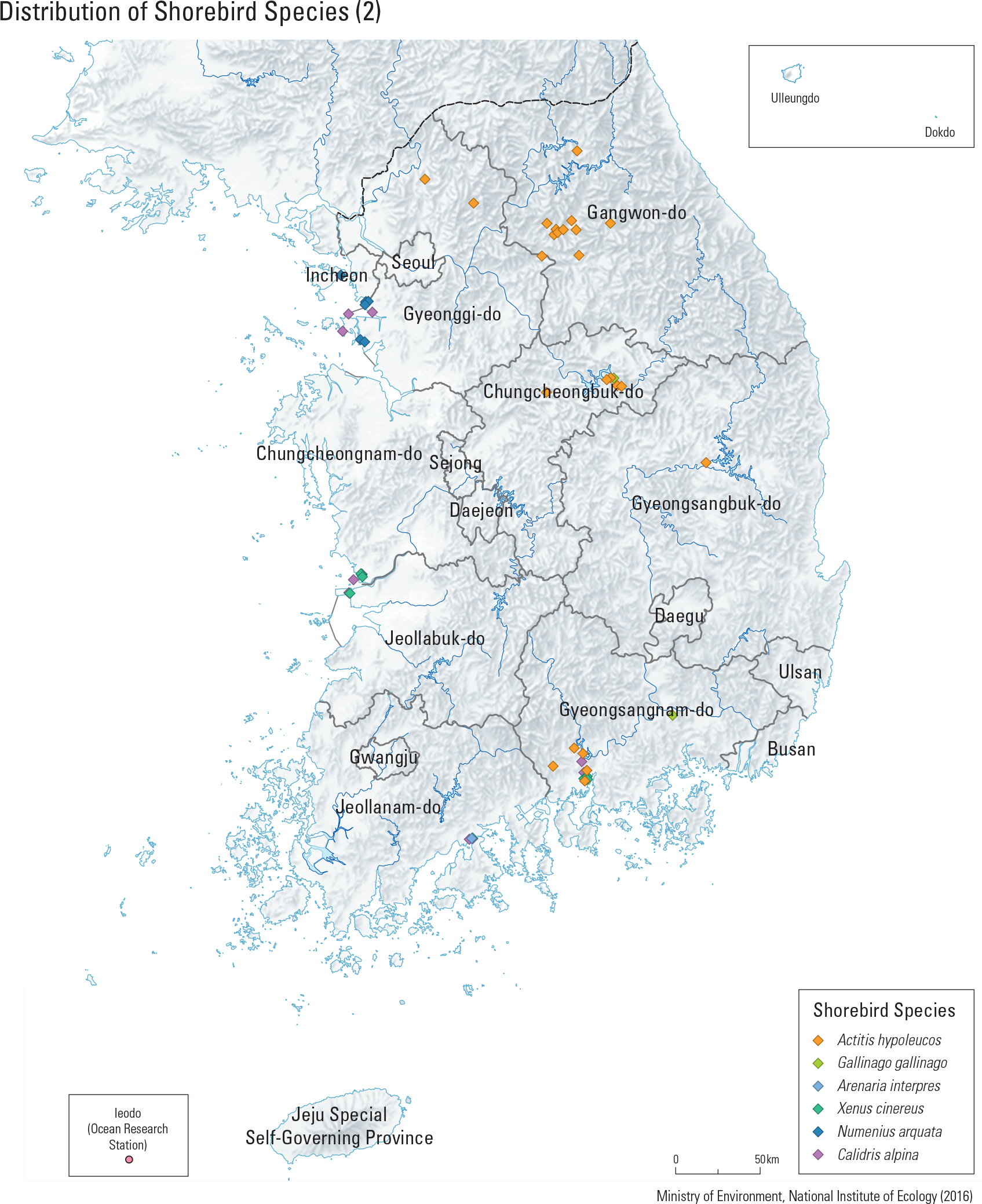English II
Belonging to the order Gruiformes, cranes are large in size with long legs and necks. Globally, cranes be- long to 4 genera and 15 species. In regions of North- east Asia, several species reproduce here including the red-crowned crane (Grus japonensis), white- naped crane (Grus vipio), hooded crane (Grus mo- nacha), and demoiselle crane (Anthropoides virgo), while the Eurasian crane (Grus grus) and Siberian crane (Grus leucogeranus) can be observed during migratory and wintering seasons. Cranes inhabit wetlands or grasslands. The win- tering season in South Korea spans from October to March, during which the flock migrates south from its summer habitat. Cranes display diurnal behaviors, differentiating sleeping grounds and feeding territo- ries in wintering areas in South Korea, and mostly feed on plant bulbs and fallen grains and invertebrates in cultivated elds. Seven species of cranes inhabit South Korea, in- cluding the red-crowned crane, white-naped crane, hooded crane, Eurasian crane, sandhill crane (Crus canadensis), Siberian crane, and demoiselle crane. The red-crowned crane, white-naped crane, and hooded crane mostly winter in South Korea. The hooded crane inhabits South Korea only temporarily as a migratory stopover; however, the population of hooded cranes has been increasing recently. Of the cranes inhabiting South Korea, the red-crowned crane and Siberian crane are globally endangered species, In particular, the red-crowned crane is pro- tected and designated as both, an Endangered Wild Species Class I and a Korean Natural Monument. With very few recorded observations in South Korea, the Siberian crane is not protected under the law but is classi ed as Endangered on the IUCN Redlist. Of 62 species of herons around the globe, 18 species inhabit South Korea. The nine major spe- cies are the black-crowned night heron (Nycticorax nycticorax), Chinese pond heron (Ardea cinerea), great egret (Ardea alba), intermediate egret (Egretta intermedia), little egret (Egretta garzetta), Chinese pond heron (Ardeola bacchus), cattle egret (Bubul- cus ibis), Pacific reef egret (Egretta sacra), and Chinese egret (Egretta eulophotes), which breed in flocks around low hilly forests near villages or in the woodlands of uninhabited islands. The Chinese little bittern (Ixobrychus sinensis) and Schrenk’s bit- tern (Ixobrychus eurhythmus) breed in single pairs in emerging plant communities, while the green- backed heron (Butorides striatus) breeds in single pairs in woodlands. Records from 2009 indicate sightings of Japanese night heron (Gorsachius gois- agi) breeding in Jejudo and Gubongsan of Busan. While rarely spotted, the spring and autumn mi- gratory seasons are the time of year to occasionslly see the cinnamon bittern (Ixobrychus cinnamomeus), black bittern (Dupetor flavicollis), and purple heron (Ardea purpurea), while the striated bittern (Botaurus stellaris) is rarely spotted during the winter season. Single individuals of the Malayan night heron species (Gorsachius melanolophus) are on record as having been rescued in Gunsan-si in 2006. Forest birds consist of 244 species that reproduce in, winter at, or temporarily inhabit the forest region. Forest birds can be categorized into species displaying strong forest habitat preference (residing and feeding in forests), intermediate forest habitat preference (ei- ther residing or feeding in forests), and weak prefer- ence (migrating through forests). Of forest birds, 188 species belong to the group displaying strong prefer- ences, 46 belong to the group of intermediate prefer- ences, and 10 belong to the weak preferences group. As a long-term ecological study, the Forest Bird Density Survey has been continuing since 2003 around the areas of Gwangneung, Gyebangsan, Geumsan, and Jejudo. Since 2015, the study has expanded to the regions of Baekdudaegan, including nests in forests, rivers, farmlands, and the settle- ments of Jirisan, Odaesan, Taebaeksan, Sobaeksan, and Deogyusan.
page_2 |





